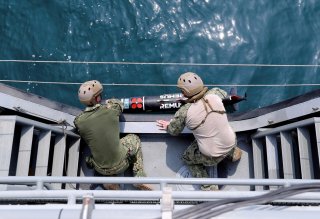The Navy's 2023 Budget Doubles Down on Underwater Drones
The massive expansion in undersea drones is consistent with the Navy’s heavily emphasized Distributed Maritime Operations strategy.
In recent years, Navy modernization has been characterized by a highly-visible and important uptick in unmanned systems development and production. The Navy’s recently released 2023 budget is no exception, and the service’s request to procure as many as twenty-two small and medium undersea vehicles continues this emphasis on unmanned systems.
The emerging fleet of undersea drones ranges from small, semi-autonomous mine-hunting drones to enormous, submarine-like drones such as the Large Displacement Unmanned Undersea Vehicle and the Extra Large Unmanned Undersea Vehicles (XLUUV), which can potentially even carry torpedoes.
The massive expansion of the Navy’s undersea drones program is consistent with the Navy’s heavily emphasized Distributed Maritime Operations (DMO) strategy. The strategy calls for a dispersed but highly networked force of manned and unmanned systems capable of sharing time-sensitive targeting and reconnaissance data across the force in real-time. The networking is also intended to be multi-domain, which would allow undersea drones to connect with surface ships and even air assets such as helicopters. For instance, an undersea drone could share intelligence with a helicopter as it lowered sonobuoys into the water for mine and submarine hunting operations. In keeping with the Navy’s DMO strategy, a greater number of unmanned vehicles will support the Navy’s strategic call for “distributed” operations, as less condensed maritime forces are less vulnerable to destruction by enemy forces.
Some aspects of undersea sonar and drone synergy are greatly improved by new levels of autonomy and semi-autonomy. This allows undersea drones to find, identify, and ultimately destroy enemy mines autonomously when they are directed to do so by a human. For example, a submersible Raytheon-built AQS-20 undersea sonar system can network with a semi-autonomous, mine-exploding Barracuda drone. Raytheon explains that the AQS-20 is a submersible cylinder-like system with four built-in sonars used to find mines from the “sea-floor to the near-surface in a single pass.”. It operates with side-scanning synthetic aperture sonars, a “wide-band” forward-looking sonar, and a “digital gap” filler sonar to identify mines underwater. The AQS-20 uses acoustic ID technology and advanced automatic target recognition to generate high-resolution renderings of threats.
Navy documents further specify that the Barracuda will use wireless communications, allowing for a “tetherless” operation with the Mine Countermeasures Unmanned Surface Vehicle (MCM USV). Navy statements indicate the Barracuda will first deploy from Littoral Combat Ships before potentially migrating to other surface or airborne platforms.
Kris Osborn is the Defense Editor for the National Interest. Osborn previously served at the Pentagon as a Highly Qualified Expert with the Office of the Assistant Secretary of the Army—Acquisition, Logistics & Technology. Osborn has also worked as an anchor and on-air military specialist at national TV networks. He has appeared as a guest military expert on Fox News, MSNBC, The Military Channel, and The History Channel. He also has a Master’s Degree in Comparative Literature from Columbia University.
Image: Reuters

